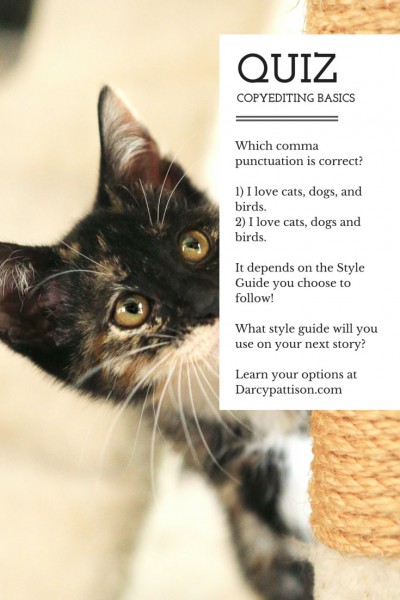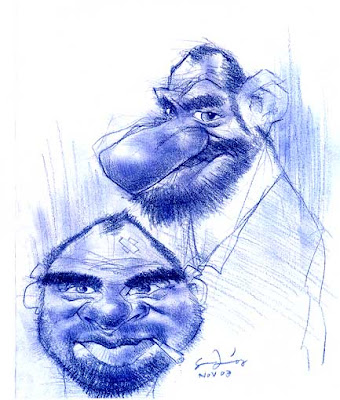Here’s a question about punctuation, with an answer about style.
Which of these is correctly punctuated?
I like oranges, apples, and bananas.
I like oranges, apples and bananas.
The answer is it depends on the style manual that you use.
In school, you were probably taught certain rules about punctuation, and your teachers told you that the rules were the “right” way to punctuate. There were no options, no other ways of working.
The reality is that punctuation conventions are just conventions that people agree upon. Two major style guides ar the Associated Press style guide, which is often used by newspapers, and the Chicago Manual of Style, often used by publishers. To make matters more complicated, often a publishing house will follow a “house style,” that is, they will decide that all of their books will follow certain punctuation rules.
In the example above, the AP style would add that last comma, but the Chicago style wouldn’t.
I like oranges, apples, and bananas. (AP Style)
I like oranges, apples and bananas. (Chicago Manual of Style)
When my first book was published by Grennwillow/Harpercollins, of course, it went through extensive editing. I was shocked and embarrassed by the red ink that came back to me on the edited manuscript. In truth, I didn’t do so badly. They were simply applying the house style to my story. Copyeditors use a style manual as they edit.

Copyedit According to Style
What does this mean for your story? Well, you have options.
First, you could just write the best story you know how, copyedit the best you know how–and then trust your publisher’s copyeditor to finish the process. It works.
Or, you could study one of the style manuals and stick with it strictly. For fiction, the best option is probably the Chicago Manual of Style. Learning a style guide down cold is technical stuff, and takes focus and an eye for detail; but it can be done.
If you’re self-publishing, you can still choose one way or the other; the difference is that you’ll be hiring the copyeditor and will tell them what style to use.
Personally, I’ll admit it: I don’t have an eye for detail necessary to be a good copyeditor. It would be painful for me to strictly follow a style manual. With each story, I learn more and more about things I should or shouldn’t do; however, I’ll never be perfect. Well, no one will be perfect–see this post on continuity goofs and other errors. But a good copyeditor can get your story pretty close to perfect. I let them do what they do best while I do what I do best, which is to tell a story.
Be very sure: that’s not a copout. I’m not ignoring the issue of punctuation. Writers should take it seriously and know the basics and know when and how they can stretch the punctuation. One of my favorite books for learning basic punctuation is The Art of Styling Sentences: 20 Patterns for Success. Grab a friend and learn a new sentence pattern every week for twenty weeks. Practice the pattern that week by using it in emails back and forth, or in postings on FB or your fav social media channel.
I will always value a good copyeditor! If you’re a grammar witch–I love you! (Just don’t email me about any mistakes in this post.)

In this January 6, 2013 NPR interview, John Sandys talks about inconsistencies in movies that were released in 2012:
Well, I think ’cause “Men in Black 3″ travels back and forth in time, it means you’ve got a whole host of factual mistakes as well, which it opens itself up to. One which jumped at me was in Cape Canaveral in 1969, we see the flag of Spain waving, but it’s the wrong flag. It’s the current era flag, not the 1969-era flag. I mean, it’s hardly a major research job. I don’t know whether they thought it wasn’t worth looking into or they just thought, well, no one will care.
This week, I am doing a final pass through of a novel and finding tons of inconsistencies.
For example, the main character shows up in a cloak and a scarf wrapped around her head. But at the beginning of the next scene, which is a direct follow-up, she throws back her hood and takes off her cloak. In another scene, she is described as wearing a cape.
(I know: Capes are soooo out of style.)
Reading and revising for consistency of details is different than reading for story. Here are a few tips:
- Put on your editor’s hat. This isn’t the time to worry about the story line, characterization, plot or those other big issues. Instead, you need to be very logical and you need to pay attention. That requires a different mindset.
- Take notes. I use sticky notes, but you could use just a sheet of paper to jot notes. As I read along, I jot down anything that sounds fishy to me, or I am uncertain of consistency through out the manuscript: numbers, names, eye color, hair color, peculiar or unusual wordings, etc. For complicated books or series, some suggest a Story Bible, or a place where you record all such details. For this story, I didn’t feel the need for something that structured. But in an upcoming series, I will definitely go that route.
- Timeline. Lots of what I am doing this week is tightening the time line. I had to cut some scenes and that left my character at a loss for an afternoon and evening. So, I moved some scenes to fill in those spaces. Often, I will literally fill in a calendar for the final timeline (after the major revisions), and often it will be hour by hour. I know I planned it all out before, but the revisions make a difference. So, I do it again.
- Words and phrases. I also make sure I haven’t repeated a word or phrase too often. It’s hard to describe how this one works, but you sorta have a watcher in your head paying attention to how a story is told. And it will go, “Whoa! Stop right there, little missy.” So, I stop and correct. It’s paying attention to the difference between work table and workbench.

- Logic. It’s important for every action to be in the correct time order and to be logical. Clarity rules on this pass through. You can’t hit a ball with a bat if you haven’t picked up a bat first.
Of course, I am making these types of decisions as I write the manuscript, but I’ve found I need one last run through. What else do you check for in your last pass through a manuscript?

Simplify Your Picture Book Story
I’m currently revising a picture book and my major goal is to simplify the story.

Simple Steps to Revision
- Why simplify the story? At 1200 words, the picture book text is way too long. I needed to cut it about in half. Why? Sue Edwards has just been reading 50 picture books in a short amount of time - something you should do at least once a year if you write picture books - and she reports that “. . .short sells. I ran into very few longer books.” Simplified = Sales. Good enough reason.
- Omit Major Character. In fact, this version of the story had already simplified by leaving out a major character. It meant a total reworking of the story, but it flowed much smoother.
- Cut the conflict in half and expand what’s left. Given that 600 words is a worthy goal, what could I do? I took the first half of the story and expanded it into the whole story, thus simplifying it by leaving out the conflict in the last half of the original. It sounds drastic and it was. But after it was done. I wondered how I could ever have thought we needed that last half.
- Planning for interactivity. In the next revision, I plan to strengthen the interactivity of the story. I already have one section where kids can anticipate and chime in. I”m looking for a couple more places.
- Planning for stronger language. The cuts I’ve done so far are playing up the fun language of the story. But I think it needs more tightening, so the fun phrases will shine.
- Planning for unique characters. A friend reminded me that my characters are too stereotypical. But with minor edits, I can remove the stereotypical references and leave the characters stronger.
- Planning to connect the beginning and end. The motivation at the beginning and the resolution at the end are still not matching up exactly. It’s close - but not right. I’m searching for alternative ways of setting it up. Because I like the new ending, which means the beginning has to set up that ending.
Not much to revise, huh? And people think writing a picture book is easy?
Post from: Revision Notes
Revise Your Novel!
Copyright 2009. Darcy Pattison. All Rights Reserved.
Related posts:
- Begin at the Beginning
- Picture Book 2
- Picture Book 3


" i am trying my new Hat! "
-Studio69
Back to your routine? I am. The snowman is in, the bells are down; no matter these things are standing in my living room, the neighbors can't see them, so they think I'm all packed up like they are.
I had a bit of a problem bringing the snowman in--I didn't know it, but a lizard had stowed away and clung to the snowman until we got into the house. He waited until I closed the door before he jumped off. Screaming comes naturally to me. Some reactions people verbalize only when others are around, such as laughing at a TV show, but for me, screaming works with or without an audience.
Part of getting back into the routine includes organizing and cleaning. I've done the easy part. I've bought stuff to organize and clean with. That counts, right?
I finished the copyedit for Violet Raines Almost Got Struck by Lightning, and FedEx is taking it up to New York today. This being my first novel, it was also my first copyedit. I knew it wouldn't involve the broad suggestions of the editorial letter or the turning of phrases in the line edit, but I wasn't really sure what to expect. Here's what the copyedit addressed: a few word changes, a few tense changes, mechanical issues (punctuation, italics/Roman, compound or hyphenated words), and some queries to confirm the material. The copyeditor did a great job; I learned a few things and I might have to pass my Danette-the-Dictionary crown (acquired in sixth grade) to her. She also left smiley faces on the manuscript here and there--you can't beat that!

During this festive season, i would like to wish you and your loved ones a Happy Holidays! Please enjoy your time with family and friends.
For those of you who are celebrating Christmas, i wish you a Merry Christmas! and Happy New Year!
Sincerely,
Samsudin Ismail
Studio69

Rough sketch of Michael Jackson - 20 minutes to this stage.:) we are all getting older...time pass very fast...HAPPY NEW YEAR!
++Studio69

Sketch of Nelson Mandela - 20 minutes rendering. -using derwent sketch pencil. adjusted in photoshop.
++Studio69

Self portrait doodling...sketch on A4 paper sketch book using derwent sketch pencil. :)
++Studio69

A sketch for Diluc - Argentinian Caricature Artist. Its a good site - offer a challenge to draw famous people every month...check it out.
Sketch on A4 paper using derwent color pencil - Blue Grey. 25 minutes to finish.
-myfreesketch. - Get yours now!

SFG : Dead President. Ink on paper. (Kilometrico ball point on 80gsm white paper).
-Get your f*ree sketch here!















Hey that sounds superb. Lemme know when it hits the shelves--I'll have to get a copy. Good on ya and good one!
Cover art, cover art!
Wayne,
Thanks! When it hits the shelves, I probably won't be able to talk about anything else!
Stephen,
YES! Cover art! That's being developed--I can't wait to see what they come up with.
A lizard? I'd scream too! We don't get lizards in the wild here, so that would be a definite surprise.
Cool about the smilies from the copy editor. You lucky girl.
Oh, those lizards! They gross me out. And (no good transition here) thanks! I do feel lucky--good editors and wonderful experience so far with Walker Books!
Hi Danette,
Thanks for stopping by my blog.
Congrats on your first novel! I look forward to reading about your journey.
I, too, and writing my first novel. It might be YA but probably not. I'm open to anything...
Best,
Tena
I'm a scream Queen myself. Folks say I should've rented my scream out to horror movies. :)
I stepped on a lizard once -- I had on flip-flops and didnt' see him -- until it was too late. ugh.
Anyway -- I'm so happy for you and your new book! YAYAYAY!! What a way to start the new year!
Thanks for stopping by my blog, too!
Hugs,
Donna
Good for you, Danette! Working with copy editors used to be something I did a lot of in Tokyo, but it was a whole different ballgame in Japan.
As for screaming without an audience, I can do this too and frequently do. I used to do this a lot when there were large cockroaches that flew residing in our house. Lizards tend to make me smile, but we don't have any here.
Congrats!!! And I agree with Stephen--can't wait to see the cover art!
:-)
Congratulations on doing your first copy edit--and survivng the lizard!
WHEN LIZARDS ATTACK!
On Fox. At 9.
CONGRATULATIONS on finishing your copyedits!! I am so excited for you, Danette. Your copy editor sounds awesome!!
It should be a rule that lizards and snowman to do co-inhabit the same area at the same time.
CONGRATS on your first copy-edit... I scream at everything and everything. In fact, I'd probably still be screaming now.
Very cool, Danette! I too can't wait to see your cover!!
Ok - so you know I like those little cute salamanders. But are you talking small and cute or big and scary? Those would make me scream.
Smiley faces are good. Devil horns bad.
You and Mother Nature do have your moments don't you? grin...
What an exciting process to be going through...
Do you have any say in the cover art? Do you know how long it will take before you get to see the cover art?